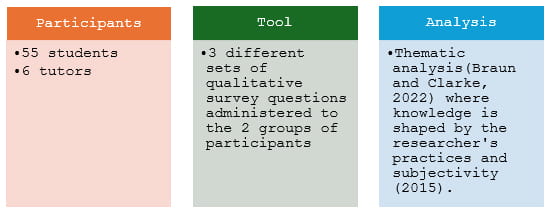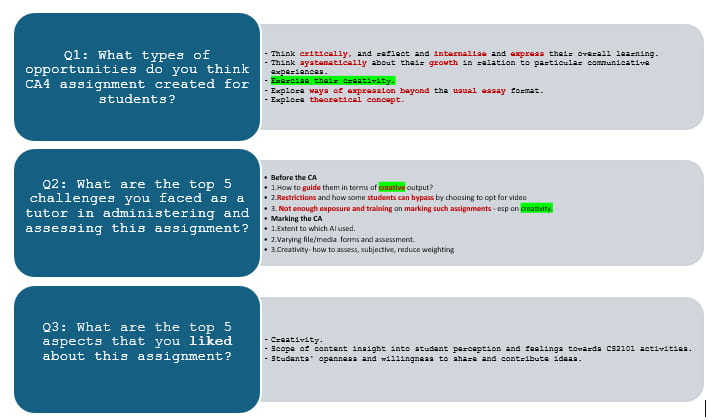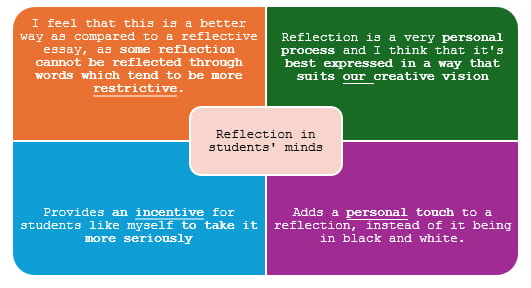Chitra SABAPATHY
Centre for English Language Communication (CELC)
Editor’s Note: Chitra shares a summary of the findings from the study she presented at HECC 2023 under the sub-theme “AI and Education”

this photo (by unknown) is licensed under CC BY-NC-ND.
Sabapathy, C. (2024, April 27). Unessay—Gateway to future higher education (HE) assessments in an AI world? [HECC 2023 Summary]. Teaching Connections. https://blog.nus.edu.sg/teachingconnections/2024/04/27/unessay-gateway-to-future-higher-education-he-assessments-in-an-ai-world/
In retrospect, presenting my paper—”Unessay- Gateway to Future HE Assessments in an AI World?—at HECC 2023 stirred a whirlwind of emotions within me. The pedagogical approach I adopted was a leap, as it was a departure from conventional methods typically employed in communication tasks, particularly reflection essays. I was not sure how the presentation was going to be received by the NUS fraternity. So, while the prospect of sharing my thoughts and classroom-based research findings was exhilarating, I could not shake off the apprehension about the reception it would garner from the audience.
Briefly, the aim of my presentation was to facilitate discussions and reflections on the unessay concept and how this could be integrated into HE assessment, serving as a potential gateway to a more diverse and inclusive assessment framework.
I began with how the rapid advancement of generative artificial intelligence (AI) has caused educators to find that their assessments (Kung et al., 2022) and pedagogies being vulnerable to them. That AI should not be simply cast as the villain, particularly with the integration of tools like ChatGPT into students’ educational experiences, and that efforts are ongoing to embrace and utilise these technologies in education (Dawson, 2020) and design assessments that could represent “future realities” of respective disciplines.
My presentation highlighted the potential benefits of adopting “unessay” as an alternative pedagogical approach in higher education. Unessay provides students a degree of freedom, necessitates ownership, fuels passion (Jakopak et al., 2019), creativity, critical thinking, interdisciplinary understanding wherein individuals articulate their ideas, beliefs, and identities. Students can select their own topic within a specific subject area and determine their preferred presentation method, if it is both captivating and impactful (O’Donnel, 2012). In essence, these equip students with important skills needed to navigate a future driven by AI and grant them the liberty to explore alternative modes of expression (Nave, 2021). What is also compelling about this approach is its ability to foster motivation and engagement in students’ academic endeavours. It encourages them to contemplate their intended audience, select suitable rhetorical strategies, and adeptly synthesise information—key elements inherent in nearly all communication tasks.
Using unessay in academia is not new. Previous studies show how they have been uniquely applied in history classes (Guiliano, 2022; Irwin, 2022; Neuhaus, 2022), histology of organ cells, (Wood and Stringham, 2022), computer programming (Aycock et al., 2019), writing (Jakopak et al., 2019; Sullivan, 2015), and applied cognitive psychology (Goodman, 2022).
At the point of the presentation, this approach might have been introduced for the first time in a communication course such as CS2101 “Effective Communication for Computing Professionals”, where the final reflection assignment diverged from conventional written reflection essays. I termed the assignment as “Insightful Musings”. In this assignment, students were offered the opportunity to leverage AI and explore multimedia formats like videos, podcasts, and infographics to convey their insights from the course. Besides utilising the unessay approach, I also emphasised the importance of students applying Gibb’s Reflective Cycle (Figure 1). This framework entails describing unique experiences, reflecting on emotions, evaluating, and analysing those experiences, and concluding with a future plan.
 Figure 1. Gibb’s reflective cycle. (This photo by unknown author is licensed under CC BY-NC)
Figure 1. Gibb’s reflective cycle. (This photo by unknown author is licensed under CC BY-NC)
Figure 2 shows an overview of the method I used. Three text-based questions were posed to tutors, and students (Table 1).

Figure 2. Method used in the study.
Table 1
Three types of text-based questions posed to tutors and students

Findings from tutors’ responses to the three questions were mixed, as seen in Figure 3:

Figure 3. Findings from tutors’ responses to the three questions.
I prioritised examining students’ responses to the questions in the presentation, primarily because there was a greater volume of data available in this area and also because I aimed to delve deeper into this aspect to gain a better understanding.
In response to how they felt about the shift towards creativity and choice to create their own reflection, I grouped their responses into seven categories.
- Feelings
- Freedom and creativity
- Cater to different strengths of learner
- Shift from conventional way
- Links to communication
- The nature of reflection
- Honest admissions
The students responded positively, and expressed feelings such ‘exciting’, ‘fun’, ‘interesting’, ‘good break away’ and that it gave them ‘freedom’.

What caught me by surprise was what students had to say about the shift from conventional ways of assessing reflection essays. For instance, students appreciated the autonomy to choose their preferred presentation mode, highlighting its departure from traditional written reflections. They noted the repetitive nature of written essays in other courses, emphasising how alternative formats enhance ownership and interest in the task.

Another aspect that surprised me was how students themselves made connections between the task and communication, such as how an inherent aspect of communication requires an element of creativity and that it spans across various mediums.

Students also drew connections between the nature of the task and reflection in general.

Students also had honest admissions which I least expected:

Like tutors, students shared challenges of using the unessay method, and these included:
- It is time consuming.
- They are used to reflection essays.
- The lacked/ had limited of creativity.
- There were constraints in the assignment.
However, they also saw opportunities for capacity-building in these assignments such as how the assignment allowed them to use different mediums, learn new ways of communicating, brush up their presentational skills in a non-written medium, and learn new ways to express themselves.
To sum it all, the icing on this journey was this quote:

I concluded my presentation by sharing that sometimes, we just need to trust the process. Did this approach, even amidst the mixed feelings I had, pay off? Did I achieve my aim to facilitate discussions and reflections on the unessay concept and how this could be integrated into HE assessment? From the almost full turnout for my conference presentation, questions posed during the question-and-answer segment, and the queries I received post-presentation from colleagues from the Departments of Economics and Mathematics, NUS Business School, and the Central Library, I would like to believe so. These colleagues felt that it is time to change but that they were hesitant. I reminded them that all it takes, is to embark on the first big leap.
References
Aycock J., Wright H., Hildebrandt J., Kenny D., Lefebvre N., Lin M., Mamaclay M., Sayson S., Stewart A., Yuen A. (2019). Adapting the “Unessay” for use in computer science. Proceedings of the 24th Western Canadian Conference on Computing Education. 1–6. https://doi.org/10.1145/3314994.3325073
Dawson, P. (2020). Cognitive offloading and assessment. In M. Bearman, P. Dawson, R. Ajjawi, J. Tai, & D. Boud (Eds.), Re-imagining University Assessment in a Digital World. 37-48. Springer International Publishing.
Goodman, S. G. (2022) ‘Just as Long as It’s Not an Essay: The Unessay as a Tool for Engagement in a Cognitive Psychology Course’, Teaching of Psychology. SAGE Publications Inc., 2022(0), pp. 1–5.
Guiliano, J. (2022). The Unessay as native-centered history and pedagogy. Teaching History: A Journal of Methods, 47(1), 6-12. https://doi.org/10.33043/TH.47.1.6-12
Irwin, R. (2022). The Un-Essay, and teaching in a time of monsters. Teaching History: A Journal of Methods, 47(1), 13-25. https://doi.org/10.33043/TH.47.1.13-25
Jakopak, R. P., Monteith, K. L., & Merkle, B. G. (2019). Writing science: Improving understanding and communication skills with the “Unessay.” Bulletin of the Ecological Society of America, 100(4), 1–5. https://doi.org/10.1002/bes2.1610
O’Donnel, D. P. (2012) ‘The unessay’. 4 September. Daniel Paul O’Donnell. http://people.uleth.ca/~daniel.odonnell/Teaching/the-unessay
Nave, L. (2021). Universal design for learning UDL in online environments: The HOW of Learning. Journal of Developmental Education 44(3), 34-35. https://www.jstor.org/stable/45381118
Neuhaus, J. (2022). Introduction to the Fall 2022 Special Issue: Using the Unessay to teach history. Teaching History: A Journal of Methods, 47(1), 2- 5. https://openjournals.bsu.edu/teachinghistory/article/download/4066/2144
Sullivan, P. (2015). The UnEssay: Making room for creativity in the composition classroom. College Composition and Communication, 67(1), 6-34. https://www.jstor.org/stable/24633867
Wood, J. L., & Stringham, N. (2022). The UnEssay project as an enriching alternative to practical exams in pre-professional and graduate education. Journal of Biological Education. Informa UK Limited, 1–8. https://doi.org/10.1080/00219266.2022.2047098
 |
Chitra SABAPATHY is a Senior Lecturer with the Centre for English Language Communication (CELC), NUS. She has taught on both undergraduate and post-graduate programmes and developed courses related to Business, Technical and Professional communication skills. She has a longstanding interest in oral communication skills and is a strong proponent of collaborative, interactive, inclusive teaching, learning, and assessment methods. Her research interests are linked to inclusive higher education teaching and learning, widening participation, policy, and practice. Chitra can be contacted at elccs@nus.edu.sg. |

